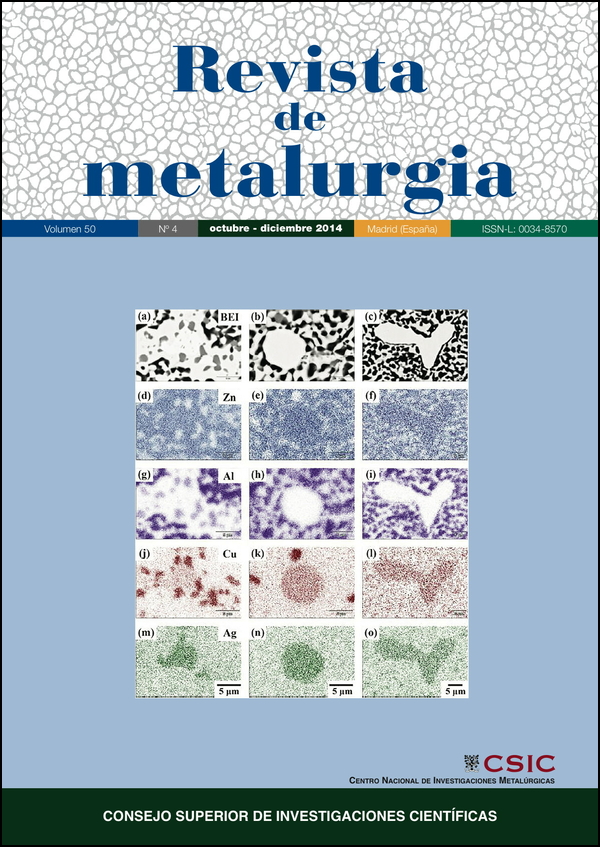Corrosion behaviour of ductile cast irons partially modified with silicon in 0.03 M NaCl.
DOI:
https://doi.org/10.3989/revmetalm.032Keywords:
Corrosion, Ductile cast iron, Electrochemical techniquesAbstract
The increasing demand of ductile cast irons with extensive technological applications leads to enlarge the corrosion resistance of this group of metallic materials. In this sense, the use of different chemical compositions on such cast irons becomes one of the most interesting aspects among the different ways to improve their behaviour against corrosion due to the extra opportunity for increasing the mechanical properties. Additionally such improvements have to be made without any increase of processing costs to keep the interesting competitiveness of developed cast irons. In the present work the preliminary results obtained from corrosion tests made on a group of cast irons with different chemical compositions are presented. Among ductile cast irons, silicon content has been varied in order to investigate the effect of this element on corrosion resistance of the alloys. The obtained results show a slight improvement of this property for the alloys with high silicon content with respect to the conventional ones though such effect was found in the first time period of the corrosion tests. Interestingly this improvement was found for alloys that exhibit better tensile properties than the conventional ductile irons. Thus an important way for developing new ductile cast irons with improved corrosion properties by alloying has been opened.
Downloads
References
Camba, C., Varela, A., Blázquez, V., García, A., Mier, J.L., Barbadillo, F. (2010). Comportamiento al desgaste de fundiciones tipo "silal". Rev. Metal. 46 (N°. Extr.), 40–46.
DeBerry, D.W., Kidwell, J.R., Malish, D.A. (1982). Corrosion in potable water systems. Final Report N° 68-01-5834, United States Environmental Protection Agency, USA.
de la Torre, U., Loizaga, A., Lacaze, J., Sertucha, J. (2014). As cast high silicon ductile irons with optimised mechanical properties and remarkable fatigue properties. Mater. Sci. Technol. 30 (12), 1425–1431. http://dx.doi.org/10.1179/1743284713Y.0000000483
Morcillo, M., de la Fuente, D., Díaz, I., Cano, H. (2011). Atmospheric corrosion of mild Steel. Rev. Metal. 47 (5) 426–444. http://dx.doi.org/10.3989/revmetalm.1125
O'Brien, J., Adams, A., Avedisian, A., Barnes, G.J., Booth, BN., Dubberstein, G., House, W., Janowak, J.F., Langnerm E.E., Lansing, J.H., Lee, RS., Nelson, C.D., Parks, TW., Peacock, J.H., Thomson, RS., Vanik, J.S., Warrick. R.J. (1974). Reference microstructure for measurement of pearlite and ferrite content in ductile iron microstructures. AFS Report. AFS Transactions 82, 545–550.
Reynaud, A. (2010). Corrosion of Cast Irons, in Shreir's Corrosion, T.J.A. Richardson, Ed. Vol. 3, Cap. 2, Elsevier, Amsterdam, The Netherlands, pp.1737–1788.
Ryntz, E.F. (1974). Reference microstructures for visual estimation of iron carbide content in nodular iron. AFS Transactions 82, 551–554.
Sun, Y., Hu, S., Xiao, Z., You, S., Zhao J., Lv, Y. (2012). Effects of nickel on low-temperature impact toughness and corrosion resistance of high-ductility ductile iron. Mater. Des. 41 (1), 37–42. http://dx.doi.org/10.1016/j.matdes.2012.03.039
Tiedje, N.S. (2010). Solidification, processing and properties of ductile cast iron. Mater. Sci. Technol. 26, 505–514. http://dx.doi.org/10.1179/026708310X12668415533649
Tullmin, M., Roberge, P.R. (2000). Atmospheric Corrosion, in Uhlig's Corrosion Handbook, Cap. 18, Ed. John Wiley & Sons.
Walter, G.G.W. (1986). A review of impedance plot methods used for corrosion performance analysis of painted metals. Corros. Sci. 26 (9), 681–703. http://dx.doi.org/10.1016/0010-938X(86)90033-8
Zhou, Y., Lu, Z., Zhan, M. (2007). An investigation of the erosion–corrosion characteristics of ductile cast iron. Mater. Des. 28 (1), 260–265. http://dx.doi.org/10.1016/j.matdes.2005.07.011
Published
How to Cite
Issue
Section
License
Copyright (c) 2014 Consejo Superior de Investigaciones Científicas (CSIC)

This work is licensed under a Creative Commons Attribution 4.0 International License.
© CSIC. Manuscripts published in both the printed and online versions of this Journal are the property of Consejo Superior de Investigaciones Científicas, and quoting this source is a requirement for any partial or full reproduction.
All contents of this electronic edition, except where otherwise noted, are distributed under a “Creative Commons Attribution 4.0 International” (CC BY 4.0) License. You may read the basic information and the legal text of the license. The indication of the CC BY 4.0 License must be expressly stated in this way when necessary.
Self-archiving in repositories, personal webpages or similar, of any version other than the published by the Editor, is not allowed.
















